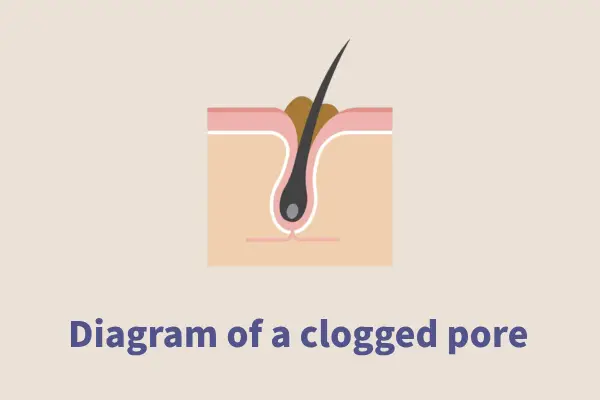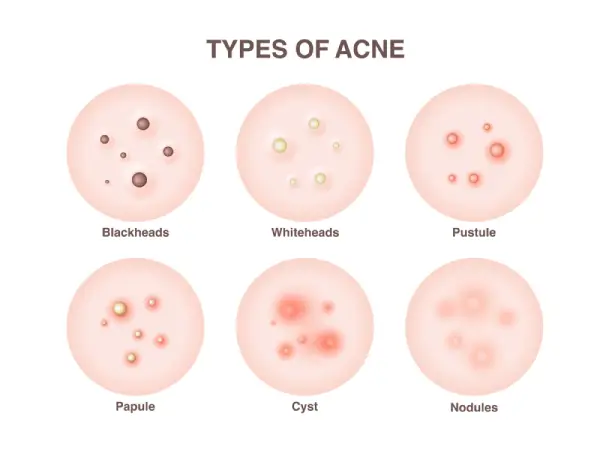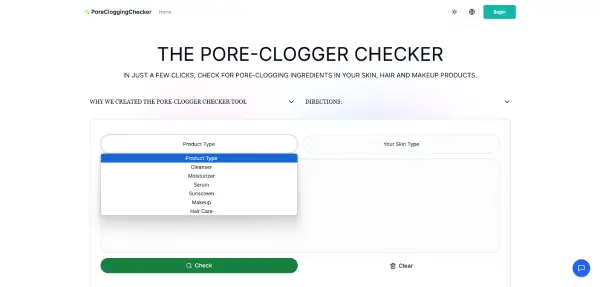The Ultimate Guide to Pore Clogging Ingredients
Feeling frustrated by breakouts despite a careful skincare routine? You diligently cleanse, moisturize, and maybe even exfoliate, yet those pesky bumps keep appearing. The culprit might be hiding in plain sight: within the ingredient lists of your favorite products. Feeling lost deciphering those long, complicated names? You're not alone. What exactly are pore clogging ingredients anyway? This guide will illuminate the world of comedogenic culprits and empower you to make smarter choices for clearer, healthier skin.
What Exactly Are Pore Clogging Ingredients?
At its core, understanding pore clogging ingredients starts with understanding how breakouts form. Our skin produces sebum (natural oil), which normally travels up hair follicles and exits through pores. However, when excess sebum mixes with dead skin cells and potentially problematic ingredients, it can form a plug, blocking the pore. This leads to various forms of acne, like whiteheads, blackheads, and inflammatory pimples.

Defining "Comedogenic" and "Acnegenic"
You'll often encounter two key terms when discussing problematic ingredients:

- Comedogenic: Derived from "comedo" (the technical term for a clogged pore like a blackhead or whitehead), comedogenic ingredients have a tendency to block pores.
- Acnegenic: This term refers to ingredients that are likely to cause or worsen acne, which can include comedogenic effects but also irritation or inflammation that leads to breakouts.
While often used interchangeably, knowing the distinction helps understand how an ingredient might affect acne prone skin.
Why Some Ingredients Clog Pores (The Science Simplified)
But why do certain skincare ingredients cause this blockage? Several factors can contribute:
- Occlusivity: Some ingredients form a thick barrier on the skin, potentially trapping sebum and dead cells underneath.
- Follicular Irritation: Certain substances can irritate the lining of the hair follicle, leading to inflammation and cell buildup that contributes to clogging.
- Interaction with Sebum: Some ingredients might alter the consistency of your natural sebum, making it thicker and more likely to clog pores.
Understanding this basic science helps appreciate why checking ingredient lists is so vital.
Understanding the Comedogenic Scale (0-5 Rating)
To help navigate the world of comedogenic ingredients, a rating scale was developed, typically ranging from 0 to 5:
- 0: Considered non-comedogenic (unlikely to clog pores).
- 1: Slightly comedogenic.
- 2: Moderately low comedogenic potential.
- 3: Moderately comedogenic.
- 4: Fairly high comedogenic potential.
- 5: Highly comedogenic (very likely to clog pores).
How the Rating System Works
This comedogenic scale was primarily based on initial studies, often involving applying concentrated ingredients to rabbit ears or sometimes human backs. Ingredients were then observed for their ability to cause comedones.
Important Limitations of the Comedogenic Scale
So, is the scale the final word? Not quite. It's a helpful starting point, but crucial limitations exist:
- Testing Methods: The original tests don't perfectly replicate how ingredients behave on human facial skin within a complex product formulation.
- Concentration: The scale doesn't usually account for the concentration of an ingredient in a final product. A highly rated ingredient might be harmless in a tiny amount.
- Formulation: How an ingredient interacts with others in the formula significantly impacts its effect.
- Individual Skin Type: Your unique skin type and sensitivity play a massive role. What clogs one person's pores might be perfectly fine for another.
Therefore, use the scale as a guide, but don't rely on it exclusively.
Common Pore Clogging Ingredients to Watch Out For
While individual reactions vary, certain ingredients frequently appear on lists of potential pore clogging ingredients. Remember, this isn't exhaustive, and presence doesn't automatically mean breakouts, but these are worth noting:
Oils and Butters Known for Clogging Pores
- Coconut Oil: Widely loved for hair and body, but often rated highly comedogenic (4-5) and notorious for causing facial breakouts in susceptible individuals.
- Cocoa Butter: Another rich emollient, frequently rated around 4.
- Soybean Oil (Glycine Soja Oil): Can be moderately comedogenic for some (often rated 3).
- Wheat Germ Oil: Often rated highly (5).
Waxes and Thickeners That Can Be Problematic
- Lanolin (and its derivatives like Acetylated Lanolin Alcohol): While excellent for very dry skin, can be comedogenic for others.
- Isopropyl Myristate, Isopropyl Palmitate, Isopropyl Isostearate: Fatty acid esters often used for texture, but known to be highly comedogenic (4-5) for many.
- Myristyl Myristate: Another ester frequently flagged.
- Beeswax (Cera Alba): Generally considered low (0-2), but can be problematic in high concentrations for some.
Certain Emulsifiers and Surfactants
- Laureth-4, Sodium Lauryl Sulfate (SLS): While SLS is primarily known as an irritant, some sources list it and related compounds as potentially comedogenic.
Potential Red Flags in Colorants and Pigments
- D&C Red Dyes: Certain red pigments used in cosmetics have been flagged in some comedogenicity lists.
This list highlights common suspects, but how do you actually check your own products?
How to Identify Pore Clogging Ingredients on Labels
Decoding labels is key. How can you spot pore clogging ingredients hidden in a long list?

Reading the INCI List: Tips and Tricks
Cosmetic ingredients are listed using the International Nomenclature of Cosmetic Ingredients (INCI). Key things to know:
- Order Matters: Ingredients are listed in descending order of concentration, down to 1%. Ingredients below 1% can be listed in any order.
- Focus on the Top: Ingredients listed first make up the bulk of the product. If a known comedogenic ingredient is high on the list, it's more likely to be problematic.
Manually cross-referencing long lists can be tedious and prone to errors.
Using an Ingredient Checker Tool (Like Ours!)
The easiest and most efficient way? Use a dedicated tool designed for this purpose. Our pore clogging checker allows you to simply paste an ingredient list, and it instantly analyzes it against a database of known comedogenic and potentially problematic ingredients. It takes the guesswork out and saves you valuable time. Give it a try!

Factors That Influence If an Ingredient Actually Clogs Your Pores
Remember, simply seeing a potentially comedogenic ingredient on a list doesn't guarantee it will cause breakouts for you. Why does an ingredient bother one person but not another? Several factors are at play:
Concentration Matters: How Much is Too Much?
As mentioned, a tiny amount of a potentially pore-clogging ingredient might have no negative effect. Its position high up on the INCI list (indicating higher concentration) is a more significant warning sign.
Formulation is Key: The Sum is Greater Than the Parts
A product's overall formulation is critical. Other ingredients can mitigate or enhance the comedogenic potential of a single component. A well-formulated product might include potentially comedogenic ingredients but still be perfectly fine for many users.
Your Unique Skin Type and Sensitivity
Ultimately, your individual skin chemistry, skin type (oily, dry, combination, sensitive), and predisposition to acne are huge factors. Patch testing new products is always a wise strategy.
Why Checking for Comedogenic Ingredients is Crucial for Healthy Skin
Why should you make checking ingredients a habit? Taking a few moments to vet your products can make a significant difference:
- Prevent Breakouts: Avoiding known triggers is the most proactive step towards clearer skin.
- Make Informed Choices: Understand what you're putting on your skin and choose products aligned with your skin's needs.
- Troubleshoot Problems: If you're experiencing breakouts, checking ingredients can help identify potential culprits in your routine.
- Achieve Truly Safe Skincare: Build a routine you can trust, minimizing the risk of adverse reactions caused by pore-clogging offenders.
Knowledge is power when it comes to your skin's health.
Take Control: Your Next Steps to Clearer Skin
Navigating the world of skincare ingredients doesn't have to be overwhelming. You now understand what pore clogging ingredients are, recognize common examples, know the limitations of the comedogenic scale, and realize the importance of considering concentration, formulation, and your unique skin. Most importantly, you know how to take action.
Ready to put this knowledge into practice? Stop wondering if your products are sabotaging your skin goals. Check your product ingredients now using our free online tool and take the guesswork out of your skincare routine! It's fast, easy, and the first step towards confidently choosing products that truly support your skin's health.
What's the most surprising pore-clogging ingredient you've encountered or learned about today? Share your thoughts and experiences in the comments below!
Frequently Asked Questions (FAQ) about Pore Clogging Ingredients
What is considered the MOST pore-clogging ingredient?
While ratings vary, ingredients like Isopropyl Myristate, Isopropyl Palmitate, Coconut Oil, and Cocoa Butter are frequently cited as highly comedogenic (rated 4-5) and often cause issues for acne prone skin. However, individual reactions are key.
Are 'natural' or 'organic' ingredients always non-comedogenic?
Absolutely not. "Natural" doesn't automatically mean safe for pores. Many natural oils and butters (like Coconut Oil) are known to be comedogenic for some individuals. Always check the specific ingredients, regardless of marketing claims.
Does a "non-comedogenic" label guarantee no breakouts?
No, it's not an absolute guarantee. While helpful, the term "non-comedogenic" isn't strictly regulated. A product labeled as such should be formulated to be less likely to clog pores, but factors like individual sensitivity and the specific formulation mean breakouts could still occur. It's always best to verify the ingredients yourself if you're prone to acne.
How quickly can a pore-clogging ingredient cause problems?
This varies greatly depending on the ingredient, the product's formulation, and your skin. Some people might see comedones forming within a few days, while for others, it might take several weeks of consistent use for clogs to become noticeable breakouts.